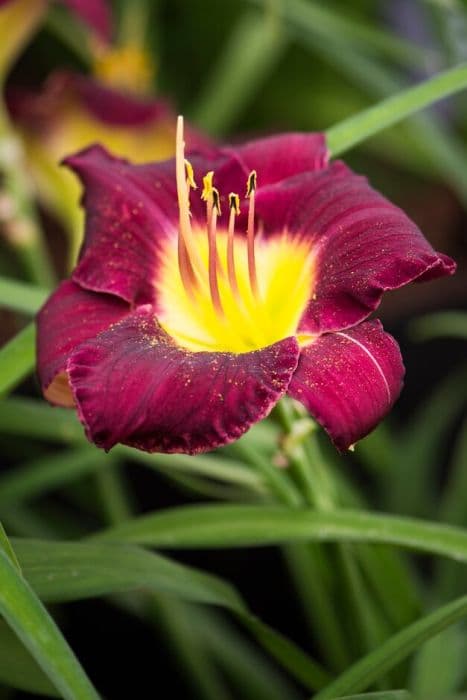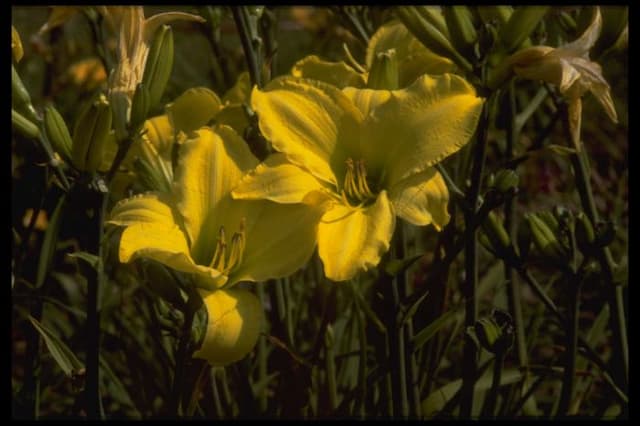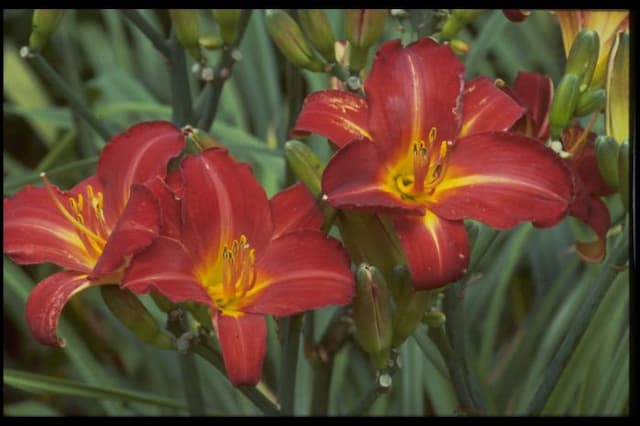Daylily Hemerocallis 'Lullaby Baby'

ABOUT
The Hemerocallis 'Lullaby Baby', commonly known as the Daylily 'Lullaby Baby', is a charming perennial plant known for its delightful flowers and lush foliage. The plant showcases an abundance of bloom which are soft in color, often characterized by pastel shades that may vary, tending to have a serene pale pink or peachy hue with a softer, almost creamy center. These flowers tend to have a trumpet-like shape, inviting a look of gentle elegance to any garden space. The petals are smooth and may display a slight ruffle along their edges, contributing to their overall delicate appearance. The flowers are supported by sturdy stalks, which rise gracefully above the clump of foliage. The leaves are long, arching, and strap-like with a vibrant green color that forms a dense and neat mound. Together, the foliage and blooms create a harmonious visual impact. The Daylily 'Lullaby Baby' typically blooms in the summer, offering a repeat performance of its picturesque flowers when the conditions are ideal. Due to its appealing blossom and ease of care, this Daylily variant is a popular choice for ornamental gardens, borders, and as an accent in mixed beds. Additionally, the plant is known to attract pollinators, adding an ecological function to its ornamental value.
About this plant
 Names
NamesSynonyms
Daylily
Common names
Hemerocallis 'Lullaby Baby'.
 Toxicity
ToxicityTo humans
The plant commonly known as Daylily 'Lullaby Baby' is not considered toxic to humans. Generally, daylilies are regarded as safe and have even been used in culinary applications; however, it is crucial to only consume plants when you are certain of their safety and have confirmed that they haven't been treated with pesticides or other chemicals. Some individuals might be allergic or sensitive to the plant, so it's advisable to proceed with caution if you’re not sure about your reaction to new plants.
To pets
For pets, mainly cats, the Daylily 'Lullaby Baby' poses a significant risk. Daylilies are highly toxic to cats and can cause acute kidney failure. If a cat ingests any part of a daylily plant, symptoms could appear within a short time and may include vomiting, lethargy, appetite loss, kidney failure, and in severe cases without prompt treatment, death. Immediate veterinary care is crucial if there is any suspicion of ingestion.
 Characteristics
CharacteristicsLife cycle
Perennials
Foliage type
Deciduous
Color of leaves
Green
Flower color
Pale Pink
Height
18 inches (45.72 cm)
Spread
24 inches (60.96 cm)
Plant type
Herb
Hardiness zones
3
Native area
Asia
Benefits
 General Benefits
General Benefits- Low Maintenance: Hemerocallis 'Lullaby Baby', commonly known as Daylily, is easy to care for and does not require extensive gardening skills.
- Drought Tolerant: Once established, Daylilies can tolerate periods of low water availability, making them suitable for xeriscaping and arid environments.
- Pest Resistance: Daylilies are relatively resistant to pests and diseases, which minimizes the need for chemical treatments.
- Attracts Pollinators: The flowers attract bees, butterflies, and other beneficial insects, supporting local ecosystems and pollination.
- Adaptable: They can thrive in a variety of soil types, from sandy to clay, as long as it is well-draining.
- Long Blooming Period: Daylilies offer a long season of blooms, usually from early summer to fall, providing prolonged garden interest.
- Versatile in Landscaping: Daylilies can be used in various landscape applications, including borders, ground covers, and container plantings.
- Erosion Control: Their root system helps to stabilize soil and prevent erosion on slopes and banks.
- Edible Parts: Certain parts of the Daylily are edible and can be used in culinary applications, though they should be consumed in moderation to prevent potential side effects.
- Variety of Colors: Daylilies come in a range of colors and patterns, 'Lullaby Baby' specifically has soft pastel tones, which can complement many garden designs.
 Medical Properties
Medical PropertiesThis plant is not used for medical purposes.
 Air-purifying Qualities
Air-purifying QualitiesThis plant is not specifically known for air purifying qualities.
 Other Uses
Other Uses- Edible blooms: The flowers of the daylily can be consumed in salads or as a decorative edible garnish on various dishes.
- Composting material: Spent blooms and leaves of the daylily can be added to compost bins to enrich the resulting compost with nutrients.
- Natural dye: The petals can be used to create a natural dye for fabrics or crafts.
- Photography subject: With its attractive flowers, the daylily is often used by photographers to practice macro-photography or to enhance garden landscapes.
- Erosion control: The root system of daylilies can help stabilize soil on slopes and prevent erosion.
- Living mulch: Planting daylilies densely can provide ground cover, conserving moisture and suppressing weeds in gardens.
- Border plantings: The neat clumps that daylilies form make them ideal for defining the edges of garden paths and borders.
- Wildlife habitat: Daylilies can provide shelter for small animals and insects within a garden ecosystem.
- Flower arranging: Daylily blooms are used in fresh cut flower arrangements, providing a rustic and colorful addition.
- Water garden accent: The daylily can be planted around ponds or water features to enhance the natural aesthetic and attract pollinators.
Interesting Facts
 Feng Shui
Feng ShuiThe Daylily is not used in Feng Shui practice.
 Zodiac Sign Compitability
Zodiac Sign CompitabilityThe Daylily is not used in astrology practice.
 Plant Symbolism
Plant Symbolism- Longevity: The common name of Hemerocallis 'Lullaby Baby' is "Daylily." Daylilies are known to live and thrive for many years, thus they symbolize longevity and survival over time.
- Renewal and Rebirth: Each flower of the Daylily typically lasts only one day, with another opening the next day. This daily cycle is emblematic of renewal and the continuous process of rebirth.
- Motherhood: The name 'Lullaby Baby' evokes feelings of nurturing and care associated with motherhood, positioning this Daylily as a symbol for the comforting and protective aspects of a mother's love.
- Beauty: Daylilies are widely appreciated for their colorful and attractive flowers, which represent beauty and the appreciation of the aesthetic.
- Forgotten or Evanescent Memory: As each bloom lasts for just a short period of time, the Daylily also symbolizes the fleeting nature of memory and the ephemeral moments in life.
 Water
WaterDaylilies, including the 'Lullaby Baby', generally require watering once a week, supplying about 1 inch of water each time. During hot spells or unusually dry periods, watering twice a week may be necessary. The best way to water daylilies is to use a soaking method, which means watering at the base of the plant rather than spraying from above, to ensure that the water reaches the roots. Avoid overhead watering to minimize the risk of leaf disease. It's important to provide a deep watering which encourages the plants to develop deep roots, thus becoming more drought-tolerant over time. Adding mulch around your daylilies can help retain soil moisture and reduce the frequency of watering.
 Light
LightDaylilies like 'Lullaby Baby' grow best in full sun, which means they should receive at least six hours of direct sunlight each day. They can tolerate light shade, especially in hotter climates, but too much shade can decrease the number of blooms. For optimal growth, plant your daylilies in a location that gets unfiltered sunlight during the morning with some afternoon shade, or in a spot that receives full day, dappled sunlight.
 Temperature
TemperatureThe 'Lullaby Baby' daylily is quite adaptable and can survive in a range of temperatures, but performs best when daytime temperatures are between 60 and 80 degrees Fahrenheit. They can endure brief periods of cold down to about -20 degrees Fahrenheit and still be hardy, lessening the chances of losing the plant to a cold winter. The ideal growing temperatures for daylilies should not be too extreme; typically, areas with moderate summers and cool winters are perfect for this plant.
 Pruning
PruningDaylilies, including 'Lullaby Baby', should be deadheaded regularly to remove spent flowers and help encourage additional blooming. After the flowering season, cut back foliage that is brown or damaged to keep the plant looking tidy and to help prevent disease. Pruning should take place in late fall after the plant has gone dormant or in early spring before new growth starts. The best time for major pruning is early spring, as this helps to stimulate new growth and prepare the plant for the blooming season.
 Cleaning
CleaningAs needed
 Soil
SoilThe best soil mix for a Daylily, commonly known as 'Lullaby Baby', should be well-draining, fertile, and slightly acidic to neutral in pH (6.0 to 7.0). A mix combining loamy garden soil, compost, and coarse sand or perlite will provide the necessary drainage and nutrients.
 Repotting
RepottingDaylilies, including 'Lullaby Baby', generally do not need frequent repotting and can thrive for years in the same location if conditions are suitable. They should be divided and repotted every 3-5 years to maintain vigor and prevent overcrowding.
 Humidity & Misting
Humidity & MistingDaylilies, such as 'Lullaby Baby', are adaptable and do not require specific humidity conditions; they can thrive in the ambient outdoor humidity of most temperate climates.
 Suitable locations
Suitable locationsIndoor
Use bright indirect light and well-draining soil for indoor Daylilies.
Outdoor
Plant in sun to part shade, enrich soil with compost, ensure good drainage.
Hardiness zone
3-9 USDA
 Life cycle
Life cycleHemerocallis 'Lullaby Baby', commonly known as the Daylily 'Lullaby Baby', begins its life cycle when a seed germinates, usually in spring after a period of stratification or cold treatment. Graduating from seedling to juvenile, the plant forms a small rosette of foliage and establishes a root system. As it matures, the Daylily enters a vegetative stage, proliferating leaves and roots and potentially forming offsets. Once mature, the plant enters the flowering stage, usually in early to mid-summer, producing distinctive trumpet-shaped blossoms that last only one day each. After pollination, which can be by insects or self-fertilization, the Daylily produces seed pods that mature and eventually release seeds to restart the cycle. During fall or winter, the foliage may die back; however, the plant endures as a perennial, regrowing from its rootstock the following season.
 Propogation
PropogationPropogation time
Late summer to early fall
Hemerocallis 'Lullaby Baby', commonly known as Daylily 'Lullaby Baby', is best propagated by division, a process that is ideally done in early spring or after the plant has finished flowering in late summer to early fall. To propagate through division, carefully dig up the clump of daylilies, trying to minimize root damage. Wash off the soil to see the natural divisions in the root system. Each division should have at least a few leaves and a portion of the roots. Separate the fans of leaves with a sharp knife or spade, ensuring each division has a good root system attached. Once divided, replant the sections at the same depth they were originally growing at, spacing them about 18 to 24 inches (45 to 60 centimeters) apart to allow for growth. Water the newly planted divisions thoroughly to settle the soil around the roots and remove any air pockets.









